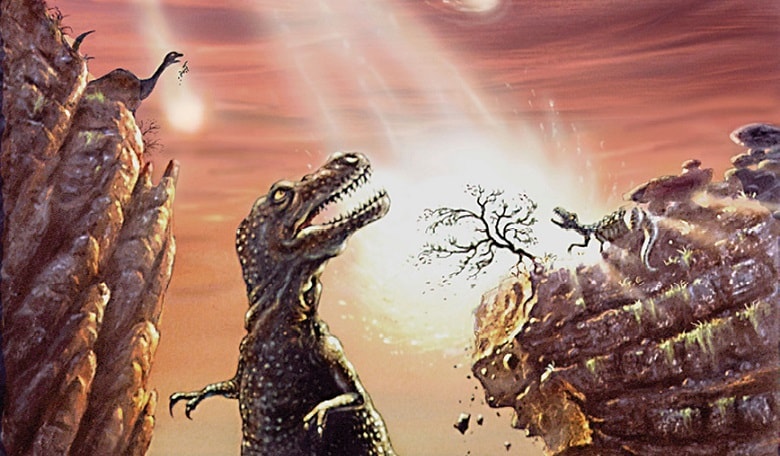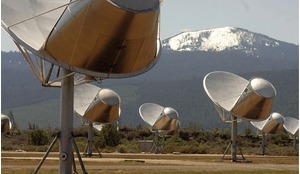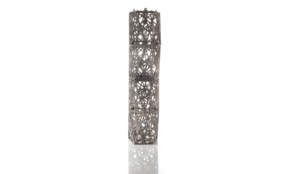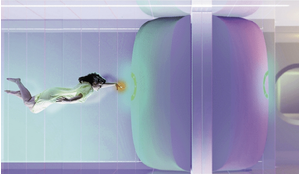In recent years astronomers have observed comet impacts with Jupiter and, in each instance, the take in the popular press has been that this is simply Jupiter doing its job as our cosmic guardian. On 19 July 2009 an object slammed into Jupiter. Although nobody witnessed the actual impact, both professional and amateur astronomers soon saw the result. The New York Times reported, ‘An object… ploughed into the giant planet’s colourful cloud tops sometime Sunday, splashing up debris and leaving a black eye the size of the Pacific Ocean…That’s Jupiter doing its cosmic job, astronomers like to say…. Part of what makes the Earth such a nice place to live, the story goes, is that Jupiter’s overbearing gravity acts as a gravitational shield deflecting incoming space junk, mainly comets, away from the inner solar system where it could do for us what an asteroid apparently did for the dinosaurs 65 million years ago.’ [1]
Jupiter experienced another impact on 10 September 2012, this one witnessed by multiple amateur astronomers. Time reported, ‘Jupiter’s extra-strong gravitational pull and its location near the asteroid belt means it’s suffered its fair share of impacts - several similar ones, by objects estimated at 10 m across, have been recorded since 2009. The latest is an opportunity to study not only the frequency with which Jupiter gets struck by small to medium-sized objects but also how it helps shield all of us here on Earth.’[2]
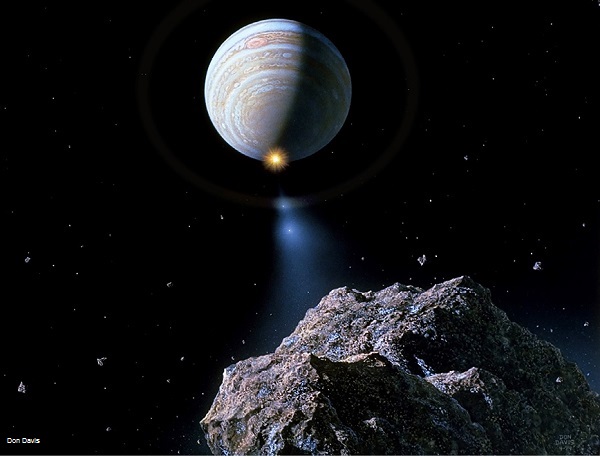 Artist’s depiction of the train of fragments of comet Shoemaker-Levy 9 during its impact with Jupiter
Artist’s depiction of the train of fragments of comet Shoemaker-Levy 9 during its impact with Jupiter
The question of whether Jovian planets shield habitable planets from impacts is an important question because impact events have both enabled life on Earth and nearly extinguished it. Early in Earth’s history it is believed our planet was struck by an object between one and three times the mass of Mars [3]. Had that impact not occurred, and removed much of Earth’s CO2-rich atmosphere in the process, our planet would likely be more like Venus with surface temperatures unable to support liquid water or life. While the Giant Impact model is being challenged by a new model [4], impact events are still a necessary part of the equation.
A rain of comets impacting a young Earth delivered the volatile compounds necessary for the formation of Earth’s atmosphere [5], hydrosphere and biosphere. [6] A newer model suggests that a growing young Earth accreted volatile material from asteroids. [7]
Once life formed and gained a foothold, the same types of impacts that delivered life-giving volatile compounds to a young Earth could subsequently sterilise it. There have been five major extinction events in Earth’s history. [8] The cause of the Cretaceous-Paleogene (formerly Cretacious-Tertiary or K-T) extinction is widely believed to have occurred after a 16 km bolide struck what is today the Yucatan Peninsula. Originally believed to be an asteroid [9], more recent analysis points to a cometary impactor as the ‘smoking gun’ that triggered this mass extinction. [10]
In each mass extinction, while some opportunistic species thrived on the carnage, Earth’s biosphere took time to recover its pre-extinction diversity. In the instance of the Permian-Triassic extinction, Earth’s biosphere took 10 million years [11], or perhaps as much as 30 million years [12] to rebound.
Even though most of the Solar System’s last surviving planetesimals were either accreted by planets or ejected into interstellar space billions of years ago [13][14][15], Earth is still hit by these Solar System leftovers on a regular basis. A study by the B612 Foundation revealed that, between 2000 and 2013, Earth was hit by 26 objects that exploded with a yield between one and 600 kilotonnes (40 times that of Hiroshima).
All life on Earth is lucky, then, because if impact events were larger or more frequent, Earth’s biosphere would be radically different than today, perhaps even non-existent. Many would claim that it has nothing to do with luck, and that we have the planet Jupiter to thank. It is a widely-held belief that Jupiter serves in the role as a cosmic shield, dramatically lowering the flux of planetesimals through the inner Solar System. This allowed Earth’s biosphere to thrive-creating a less hostile environment by lowering the terrestrial impact rate.
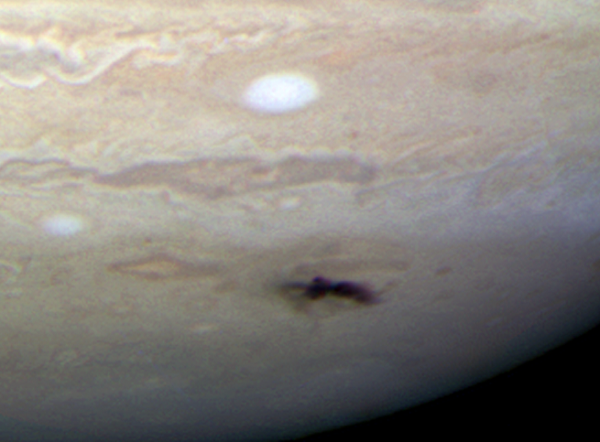 Hubble Space Telescope image of the blemish on the surface of Jupiter from the impact in 2009
Hubble Space Telescope image of the blemish on the surface of Jupiter from the impact in 2009
Some have even claimed that the presence of a Jovian planet is practically a requirement for the evolution of life on terrestrial planets. The New York Times article cited earlier continues, ‘…astronomers look for similar configurations - a giant outer planet with room for smaller planets in closer to the home stars - in other planetary systems as an indication of their hospitableness to life’. [1]
As widespread as the ‘Jupiter as comet shield’ notion is, its origin is murky. Researchers Horner and Jones [16][17] note, ‘The idea that a giant planet is required beyond the orbit of a terrestrial one, in order that a planet be habitable, is well entrenched in the astronomical community… It is hard to find the origins of the Jupiter as shield theory.’ The concept was popularised by the book Rare Earth by Ward and Brownlee [18]. In it the authors claim, ‘Because it cleans our solar system of dangerous Earth-orbit crossing asteroids and comets, Jupiter has a beneficial influence on life on Earth.’
Ward and Brownlee’s claim stems from their interpretation of a 1994 paper by researcher George Wetherill [19]. In that paper, Wetherill noted that observers had yet to witness comets on hyperbolic, interstellar trajectories ejected from their systems by Jovian planets in late-stage planet formation.
An examination of Wetherill’s paper, however, yields only one reference to Jupiter as anything resembling a shield. In regard to simulations where the Jovian planets had aquired masses significantly smaller than what they have presently - what Wetherill called ‘failed Jupiters’ - he stated that the reduced masses have, ‘effectively removed’ the Jupiter ‘barrier’ that must be penetrated by both Oort cloud and Kuiper belt comets if they are to achieve Earth-crossing orbits …’ [19] The term ‘Jupiter barrier’ has a connotation in planetary dynamics that implies Jupiter is less of an impenetrable shield, and more of a dynamical filter or membrane. [20]
In a subsequent overview paper in the ‘News and Views’ section of Nature, describing much of the same work as his 1994 paper, Wetherill concluded ‘…more easily made terrestrial planet systems physically similar to ours may be abundant but hazardous unless protected by gas giant planets.’ Taken out of context, this passage reads as if Wetherill argues in favour of Jupiter’s role as a shield, but the claim was, in fact, made in reference to Jupiter’s role in purging the outer Solar System of its last remaining planetesimals. [21]
Ward and Brownlee’s interpretation of Wetherill’s results led them to suggest that the existence of a Jovian planet in a superior orbit is practically a necessity for the evolution of life on a terrestrial planet, claiming, ‘When planetary systems lack a Jovian planet to guard the outer boundary of the terrestrial planet region, the inner planets may not be capable of supporting more than microbial life.’ [18]
The ‘Jupiter as a comet shield’ scenario became ubiquitous in television/film documentary productions as well as the popular press. Yet, for this scenario, there appears to be a selection bias, and only events where Jupiter might have shielded Earth are typically reported. The instances when Jupiter has placed Earth in its cosmic cross-hairs have gone largely ignored.
Take the recent example of comet C/1995 O1 Hale-Bopp. Based upon the orbital elements shortly after Hale-Bopp was first observed, the comet seems to have made its last perihelion passage 4200 years ago in July 2215 BC, when its closest approach to Earth was 1.4 AU.
Computer integrations show that the comet likely had a very close approach to Jupiter in June of that year, and 2215 may have been its first inner Solar System apparition. [22] When Hale-Bopp was inbound to the inner Solar System in April 1996, it made a distant pass of Jupiter. Even though the comet’s closest point of approach was 0.77 AU, its gravitational interaction with Jupiter was enough to modify the orbit, reducing its semimajor axes down to 370 AU from 525 AU. Its period, therefore, was shortened from 4200 years to just over 2500 [23]. This comet will now have more frequent passes through the terrestrial planet region and more opportunities to strike Earth.
There is the even more sobering example of Comet D/1770L1 Lexell, whose pass by Earth in 1770 was the closest cometary near-miss in recorded history - it closest point of approach was 0.0146 AU from Earth. Three years prior, the comet had a close approach to Jupiter, which altered its orbit into an Earth-threatening one. [24][25] After threatening Earth in 1770, Lexell again had an encounter with Jupiter in 1779, which ejected it from the Solar System entirely. This is a real world example where Jupiter acted as both a danger and a protector - and certainly reveals chinks in Jupiter’s armour.
Origin of the myth
Wetherill’s original research-both its goals and conclusions-were far removed from an examination of Jupiter’s role in protecting the terrestrial planets from impactors. In the days before the first detection of extrasolar Jovian planets, Wetherill questioned if these types of planets were common. He noted that building a Jovian planet is a race: can a planetary core grow large enough and fast enough to capture significant nebular gas before that gas is blown away by the system’s star in its T-Tauri phase? Previous computer simulations [26][27][28] had suggested that planetesimals situated in the gaps between the Jovian planets have very short lifetimes - the regions are dynamically unstable -and most of the simulated planetesimals initially situated in those gaps are ejected from the system entirely. Wetherill believed that larger Jovian planets would eject more comets, so he postulated that since interstellar comets had gone unobserved, Jovian planets may be rare. [19]
Wetherill performed a series of computational simulations that modeled the evolution of planetesimals - a broad term for comets and asteroids, the building blocks of planets - in the presence of Jovian planets of varying masses: planets with their present masses, and planetary cores or embryos (what Wetherill called ‘failed Jupiters’). Should the norm be that planetary systems have terrestrial planets and ‘failed Jupiters’, then Wetherill’s hypothesis was that there should be no reasonable expectation of ever seeing interstellar comets passing through the Solar System. Wetherill noted, ‘…there are several ways in which Jupiter (and Saturn) may fail to form in systems for which terrestrial planets may occur.’ [19]
Succinctly, the method he employed has crucial failure modes that have since been recognised [29][30][31] and, in a 4.5 billion year simulation like Wetherill’s, the circumstances leading to this failure mode are achieved often - for an unacceptably large fraction of the simulated planetesimals. Examinations of the accuracy of the numerical modelling technique concluded, among other things, that the method over-estimates median particle lifetimes by a significant amount [20]. Clearly, if the numerical method upon which the ‘Jupiter as Comet Shield’ paradigm relies is problematic, then the research should be revisited with computers fast enough to employ more accurate numerical methods with fewer simplifications.
Recent modelling efforts
The ‘Jupiter as comet shield’ concept become entrenched in the academic realm with little critical examination and was then propagated in the popular media. Even today a brief Internet search yields results showing it is still either 1) stated as a fact, or 2) considered open for debate, despite the fact that a growing string of papers have raised serious concerns regarding its validity. In the past decade, other researchers have recreated Wetherill’s original simulations with computational methods orders of magnitude more accurate, and have performed new, more accurate, and more thorough, analyses. [32][16][17][33][34][15]
A series of paper from two different research groups have confirmed the finding from the original work that planetesimals initially situated in the Jovian planet gaps reside there for brief periods compared to the age of the Solar System. More recent simulations have also shown that if the planets are modelled with their present masses, most of the planetesimals initially situated between the planets wind up ejected from the Solar System, and very few survive past 100 My of simulation time. [15][35]
Modern simulations have also shown that Wetherill’s ‘failed Jupiters’, although not as adept at ejecting objects from the Solar System as the full-mass versions, still eject most planetesimals that begin the simulation in the inter-planet gaps - they simply take longer. So a scarcity of interstellar comet observations is uncorrelated with Jovian planet formation in other systems, and this metric for assessing the rarity of Jovian planets was never a good one to begin with [15].
Ward and Brownlee (2000) stated, ‘In the early solar system, there were tremendous numbers of small bodies that had escaped incorporation into planets but over half a billion years most of the larger ones inside the orbit of Saturn disappeared. They were accreted by planets, ejected out of the Solar System, or incorporated into the Oort cloud of comets. Jupiter was the major cause of this purging…’
It is true that in these types of computational models very few planetesimals survive past 100 My of simulation time.[15][35] So the Jovian planets do appear to have defended the terrestrial planets in some respects by clearing out reservoirs of potential Earth impactors. On the other hand, simulations that remove Jupiter or Saturn leave a belt of material either interior to Saturn (when Jupiter is removed) or between Jupiter and Uranus (when Saturn is removed).[15]
This finding implies that Jupiter does not clear the outer Solar System alone but requires help from Saturn. Typically, Jupiter, with over three times the mass, is better able to eject objects from the Solar System but Saturn perturbs the objects into Jupiter’s path. To use a sports analogy: Jupiter scores the goal, but Saturn gets the assist. The point is clear, however, it takes more than one Jovian planet to clear the reservoir of potential Earth impactors.
Jupiter shielding in a colloquial sense
Though Wetherill’s 1994 work is often cited as the basis for the ‘Jupiter shield’ scenario, whether or not Jupiter intercepts comets bound for the inner Solar System was never a goal of the work.
In the simulations that have attempted to recreate the original work [15], gravitational interactions with the Jovian planets do not eject all planetesimals from the Solar System, at least not initially. As is believed occurred in the early days of planet formation, many of the objects that form in the Jovian inter-planet gaps are cast onto extremely elliptical orbits that travel into both the depths of the outer Solar System, and the terrestrial planet region. As these objects pass the Jovian planet region, close planet/planetesimal approaches are inevitable.
In the most recent, and computationally accurate, study, Jupiter had nearly 49,000 interactions with objects whose aphelion was beyond Neptune. Of those, only seven impacted Jupiter, five per cent were ejected, 38 per cent were perturbed into orbits with average distances farther away from the Sun, and 57 per cent were pulled into tighter orbits with shorter orbital periods similar to what happened with Hale-Bopp in 1997.
Of all these comet/planet interactions, there were only 17 for which the perihelion of the comet was less than 1 AU. This implies that most of the observed Jupiter impacts astronomers have witnessed were with objects that were not Earth-threatening.
Conclusion
One of the most important results of Wetherill’s 1994 paper was that if Jupiter and Saturn had only ever grown to the size of their core masses - to the approximate size of Uranus and Neptune - then the flux of material through the inner Solar System would be 1000 times higher today, to the inevitable detriment of Earth’s biosphere. Ward and Brownlee (2000) cite this result differently: ‘Wetherill claimed… if cometary impacts are responsible for a major fraction of Earth’s volatile inventory, its volatile content would be much [1000x] larger if gas giant planets were absent.’ This interpretation implies that Wetherill’s results were based upon a complete absence of a Jupiter. In both scenarios, the assumption has been that Jupiter alone clears out a reservoir of potential Earth-impacting bodies.
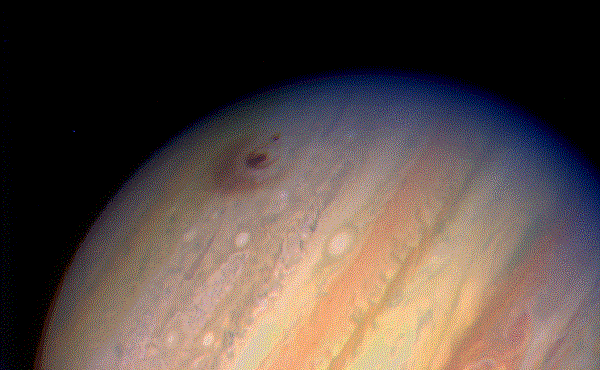
Neither claim is quite right. Highly accurate simulations reveal that although Jovian planets do help rid the Solar System of unaccreted planetesimals, Jovian planet cores also help clean up the outer Solar System on timescales far shorter than the age of the Solar System.
Perhaps the most important lesson of Wetherill’s 1994 paper might be a cautionary one. The acceptance of the ‘Jupiter as a Shield’ paradigm turns out to be an excellent example of the dangers of widespread acceptance of a concept without adequate testing, and serves as an excellent example of how unchallenged notions can become firmly entrenched in both scientific thinking and the popular zeitgeist, and then propagated dogmatically.
In the end, capricious Jupiter is not an efficient defender of the inner Solar System from comets originating in the outer Solar System, shunting as many comets towards the terrestrial planets as it deflects away. When it comes to defending Earth from these high-speed icy bullets from the depths of space, it looks like we are on our own.
References
1 Overbye, Dennis (2009) Jupiter: Our Cosmic Protector? New York Times http://www.nytimes.com/2009/07/26/weekinreview/26overbye.html, Accessed 31 October 2013.
2 Newcomb, Tim (2012) ‘Explosion’ on Jupiter: Did the Planet Take a Hit for Earth? Time http://newsfeed.time.com/2012/09/11/explosion-on-jupiter-did-the-planet-take-a-hit-for-earth/. Accessed 31 October 2013.
3 Canup, R.; Asphaug, E. (2001). Origin of the Moon in a giant impact near the end of the Earth’s formation. Nature 412 (6848): 708-712
4 Canup (2012) Forming a Moon with an Earth-like composition via a Giant Impact. Science, 338(6110):1052-5. doi: 10.1126/science.1226073.
5 Hartogh, Paul, Dariusz C. Lis, Dominique Bockelee-Morvan, Miguel de Val-Borro, Nicolas Biver, Michael Kuppers, Martin Emprechtinger, Edwin A. Bergin, Jacques Crovisier, Miriam Rengel, Raphael Moreno, Slawomira Szutowicz, Geoffrey A. Blake (2011) Ocean-like water in the Jupiter-family comet 103P/Hartley 2, Nature, 478, 218-220.
6 Thomas, Paul J., Roland D. Hicks, Christopher F. Chyba and Christopher P. McKay (2006) Comets and the Origin and Evolution of Life, 2 ed. Springer, Berlin.
7 Sarafian, Adam, Sune G. Nielsen, Horst R. Marschall, Francis M. McCubbin, Brian D. Monteleone (2014) Early accretion of water in the inner solar system from a carbonaceous chondrite-like source. Science Vol. 346 no. 6209 pp. 623-626 DOI: 10.1126/science.1256717.
8 Raup, D.; Sepkoski Jr, J. (1982). Mass extinctions in the marine fossil record. Science 215 (4539): 1501-1503. doi:10.1126/science.215.4539.1501.
9 Alvarez LW, Alvarez W, Asaro F, Michel HV (1980). Extraterrestrial cause for the Cretaceous-Tertiary extinction. Science, 208 (4448): 1095-1108. doi:10.1126/science.208.4448.1095.
10 Moore, J.R., and M. Sharma (2013) The K-Pg Impactor was Likely a High Velocity Comet. Proceedings of the 44th Lunar and Planetary Conference; Woodlands, TX.
11 Chen, Z-Q, Michael J. Benton (2012) The timing and pattern of biotic recovery following the end-Permian mass extinction. Nature Geoscience DOI: 10.1038/ngeo1475.
12 Sahney, S. and Benton M.J (2008). Recovery from the most profound mass extinction of all time Proceedings of the Royal Society, B 275 (1636): 759-765. doi:10.1098/rspb.2007.1370.
13 Grazier, K.R., W.I. Newman, W.M. Kaula, and J.M. Hyman, 1999. Dynamical Evolution of Planetesimals in the Outer Solar System. I. The Jupiter/Saturn Zone. Icarus. 140(2).
14 Grazier, K.R., W.I. Newman, F. Varadi, W.M. Kaula, and J.M. Hyman, 1999. Dynamical Evolution of Planetesimals in the Outer Solar System. II. The Saturn/Uranus and Uranus/Neptune Zones. Icarus 140(2).
15 Grazier, K.R. Jupiter: Cosmic Jekyll and Hyde, 2016, Astrobiology, 16, 1.
16 Horner, J, and B.W. Jones, (2008a) Jupiter: Friend or Foe, A&G, 49: 1.22-1.27.
17 Horner, J, and B.W. Jones, (2008b) Jupiter - friend or foe? I: The Asteroids. International Journal of Astrobiology, 7, 251-261.
18 Ward, P. D. and D. Brownlee (2000) Rare Earth: Why Complex Life is Uncommon in the Universe 235-242.
19 Wetherill, G.W. (1994) Possible Consequences of “Jupiters” in Planetary Systems, Astrophysics and Space Science 212: 23-32
20 Levison, H.F., L. Dones, and M.J. Duncan (2001) The origin of Halley-type comets: Probing the inner Oort cloud. Astron. J. 121, 2253-2267.
21 Wetherill, G.W. (1995) How special is Jupiter? Nature, 373, 470.
22 Marsden (1997) “Orbit Determination and Evolution of Comet C/1995 O1 (Hale-Bopp)”. Earth, Moon, and Planets 79 (1): 3-15. doi:10.1023/A:1006268813208.
23 Yeomans, D. (1997) Comet Hale-Bopp Orbit and Ephemeris Information. http://www2.jpl.nasa.gov/comet/ephemjpl8.html. Retrieved 10/31/2013.
24 Celletti, ?A., E. Perozzi (2007) Celestial Mechanics: The Waltz of the Planets. Springer Praxis, Berlin, pp 94-95.
25 Leverington, D. (2003) Babylon to Voyager and Beyond: A History of Planetary Astronomy, Cambridge University Press, 2003, p.193.
26 Weibel, W. M., W. M. Kaula, and W. I. Newman 1990. A computer search for stable orbits between Jupiter and Saturn. Icarus 83, 382-390.
27 Gladman, B. and M. Duncan 1990. On the Fates of Minor Bodies in the Outer Solar System, Astron. J. 100, 1680-1693.
28 Holman, M. J. and J. Wisdom (1993). Dynamical Stability in the Outer Solar System and the Delivery of Short Period Comets, Astron. J. 105, 1987-1999.
29 Opik, E.J., (1951) Collision Probabilities with the Planets and the Distribution of Interplanetary Matter, Proc. Roy. Irish. Acad., 54A, 165-199.
30 Opik, E.J., (1976) Interplanetary encounters: close-range gravitational interactions. Elsevier Scientic Publishing Company, Amsterdam.
31 Dones, L., B. Gladman, H.J. Melosh, W.B.Tonks, H.F. Levison, and M. Duncan (1999). Dynamical Lifetimes and Final Fates of Small Bodies: Orbit Integrations vs Opik Calculations, Icarus, 142, 509-524.
32 Grazier, K.R., W.I. Newman, and P.W. Sharp (2008). Jupiter as a Sniper Rather than a Shield. B.A.A.S. 40, no 3, 404.
33 Horner, J, and B.W. Jones, (2009) Jupiter - friend or foe? II: The Centaurs. International Journal of Astrobiology, 8:75-80.
34 Horner, J, B.W. Jones, and J. Chambers(2010) Jupiter - friend or foe? III: The Oort Cloud Comets. International Journal of Astrobiology, 9:1-10.
35 Grazier, K.R., J.C. Castillo-Rogez, P.W. Sharp (2014) Dynamical Delivery of Volatiles to the Outer Main Belt, Icarus, 232, 13-21.
36 Morbidelli, A. (2008). Origin and dynamical evolution of comets and their reservoirs. Lectures on comet dynamics and outer solar system formation at the 35th Saas-Fee advanced course.





